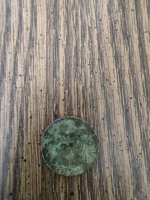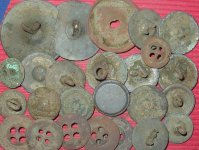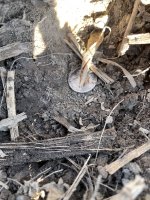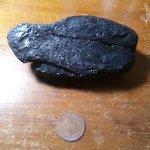S
stefen
Guest
Re: Continuation of JD's Encampment Hunt
Monty,
Found this today and thought I'd pass it on. My fiance uses yogi and her 10 years of constant pain has vertually gone away. Maybe it will help...then again?
When Backs Go Bad
Back pain—which affects an estimated 80 percent of all Americans at some time or another—can have many causes. Since your pain can be triggered by anything from muscle strain after lifting something heavy to a spinal fracture caused by osteoporosis, it's always wise to see your doctor. Fortunately, most back pain isn't serious, despite how it feels.
Most often, it's due to strained muscles, which could result from performing any number of activities when your muscles are tight—such as lifting, bending or twisting—or inactivity, which allows your back muscles to weaken and become stiff. Stress can also contribute to back pain.
As long as yours falls into the nonserious category, you can safely try these techniques the next time your back is killing you.
That's Why It Hurts So Much
Back pain can be serious torture because most of the pain receptors in your back are found in the muscle tissues. And back muscles are approximately 20 times more painful than any other muscles in the body because they're complex and located so close to the spinal cord, says Art Brownstein, MD, author of Healing Back Pain Naturally (Harbor Press, 1998). "If you were a champion basket weaver, you couldn't weave a basket so sophisticated with all the different angles and fibers as your back muscles, which orchestrate the many joints in your back."
Stretch Those Strained Muscles
Stretching—that thing you may do involuntarily when you wake up every morning—can directly relieve the back pain that emanates from strained or sore muscles, says Brownstein, assistant clinical professor of medicine at the University of Hawaii in Manoa.
Stretching elongates muscle tissues, improves blood flow and speeds delivery of oxygen and nutrients to the back. It also helps decompress the vertebrae (the 24 movable bones that make up your spine), which press on the disks, the cushionlike pads between them.
Here is a simple stretch you might want to try: Lie on your back. Slowly bring your right leg, bent, in toward your chest, only as far as comfortable. With your hands on your shin, hold this position for 10 to 20 seconds, then slowly release and repeat with your other leg. Repeat five or six times in the morning before you rise and in the evening before you go to sleep.
This can help even if your pain is so severe that you can't get out of bed—or off the floor. Start slowly and gently, gradually increasing the stretch as your back begins to loosen up and heal.
Remember to breathe deeply and fully, adds Dr. Brownstein. "Your breath is the link between your mind and body," he says. "When you're mentally agitated and upset, you can hyperventilate and not get enough oxygen. When you breathe slowly and deeply, your mind calms down, your nerves calm down and your muscles stop contracting and start to lengthen. With this, blood flow is restored and healing can occur."
Relax Spasms With Yoga
During acute lower back strain, the muscles on either side of your spine at your waist, known as the paraspinal muscles, will go into spasm and feel tender and tight. As the muscles contract continuously, they squeeze off their own blood supply and deprive themselves of oxygen, explains Mary Pullig Schatz, MD, author of Back Care Basics: A Doctor's Gentle Yoga Program for Back and Neck Pain Relief (Rodmell Press, 1992).
"You can get into a vicious circle, where the reaction of the muscles to continuous spasm and oxygen deprivation causes more spasm and thereby more pain," says Dr. Schatz. To relieve back spasms, Dr. Schatz recommends the following yoga pose:
Lie on your back on the floor. Place a rolled-up towel under your neck and towels under your head.
Place the back of your calves on a chair so that your thighs and calves form a 90-degree angle. For extra relief, place a 2-pound bag of dried beans on your belly. Your arms should be outstretched at your sides, palms facing up, at a slight distance from your body. Remain in this pose for 5 to 10 minutes. As you're doing this pose, use what Dr. Schatz calls the "relaxation breath."
Inhale through your nose, then exhale, also through your nose.
Near the end of the exhalation, count silently to yourself—1,001...1,002...1,003—allowing the air to gently escape and the exhalation to come to a natural pause. Then begin the next breath.
Continue breathing this way for 2 to 3 minutes. Then return to normal, relaxed breathing for the remainder of your time in the pose.
When you're ready to get back on your feet, roll onto one side and rest there for 1 minute before you push up into a sitting position. If you get up too quickly, you could prompt the spasms to return.
Acupressure: Fast Relief
It sounds too good to be true: You can make your back pain subside, or even disappear, by applying pressure to a particular point on your body. That's a simplified description of acupressure, a traditional Chinese technique that brings almost instant relief to back-pain sufferers.
By placing pressure on certain points on your body-points used in acupuncture—the Chinese believe that you unblock the flow of vital energy, or qi (pronounced chee). Those blockages, they say, create an imbalance of qi in the body, which can make you more susceptible to pain and illness. (Western scientists who have studied acupuncture, however, believe it may work by increasing the production of endorphins, hormonelike pain relievers your body makes in response to injury. The same may be true of acupressure.)
However, if it works—and it apparently does—acupressure brings only partial relief from back pain, says Christina Stemmler, MD, a Houston-based physician who uses both acupuncture and acupressure in her practice. Depending on the source of the problem, acupressure could lower pain by 50 to 75 percent, although acupuncture tends to bring instant and complete relief for acute back pain, she says. But if back pain strikes suddenly, you're probably not going to be anywhere near an acupuncturist, so acupressure is best for a quick fix. Dr. Stemmler recommends the following acupressure points for back pain. Press these points with the tip of a mechanical pencil with the lead retracted or with the fingernail on your index finger:
Center the pencil tip between your nose and upper lip. Apply deep pressure, hold for several seconds and release. Repeat 5 to 10 times until the pain begins to release.
Place the pencil tip between your inner anklebone and Achilles tendon, the large tendon running from your heel bone to the calf muscle. Apply deep pressure, hold for several seconds and release. Repeat 5 to 10 times.
Make a fist. On the outside of your hand, next to the pinky finger, locate the spot where the skin folds and bulges. That's your acupressure point. Place the pencil tip there, apply deep pressure, hold for several seconds and release. Repeat 5 to 10 times.
Quick Fix for "Sitting Strain"
You think of it as resting, but your back regards sitting as a real strain. Too much time on your duff for any reason can lead to back pain, says Jerome McAndrews, DC, national spokesperson for the American Chiropractic Association in Arlington, VA.
Here's why: When you sit for long periods of time, the muscles in the back of your legs shorten and contract abnormally from lack of activity. When you stand up, these muscles resist returning to their normal length and "yank" on the back of the pelvis. In turn, the muscles in your lower back, which are attached to the top of the pelvis, also get pulled. This pulling and tugging can lead to back pain, says Dr. McAndrews.
Here's how to loosen the muscles in the back of your legs:
Lie on the floor with your knees bent, feet flat on the floor.
Grasping your hands around your right thigh, gently pull one leg in toward your chest, keeping your other leg slightly bent. Only go as far as is comfortable.
Hold for 10 to 20 seconds and release. Repeat with the other leg. If your pain becomes worse, stop doing the exercise.
When you can easily do this exercise, try doing it with your inactive leg straight, but not locked. Hold a towel or rope around your leg to gently pull it toward you. Only go as far as is comfortable.
As a variation, stand on the balls of your feet on the bottom stair. To keep your balance, hold the railing with one hand. Now, let your weight carry your heels down below the level of the step to stretch out the calf muscles in the back of your legs. Hold for 1 minute. Repeat several times until you feel the calf muscles relax or "let go," says Dr. McAndrews.
Get Herbal Relief
When back pain strikes, you can reach for a nonprescription pain reliever such as acetaminophen, ibuprofen or even aspirin. And why not? They work. But some people can't tolerate their side effects, including stomach upset.
Herbs provide a natural alternative to over-the-counter pain relievers without the undesirable side effects, says Douglas Schar, DipPhyt, MCPP, a medically trained herbalist in London and editor of the
British Journal of Phytotherapy.
"Back pain is an ongoing problem for many people. They often have to use medicine off and on for long periods of time. That's where herbal medicines make a big contribution. They're milder, and they don't have the same side effects as some of the over-the-counter preparations," Schar says.
If you know what's causing your back pain, try one of the following herbal remedies:
Cramp Bark
For back pain caused by strain and overuse of muscles, Schar recommends cramp bark, a muscle relaxant that soothes spasms. Cramp bark is available as bark or as a tincture.
Tea: Add 1 teaspoon of the bark to 1 cup of boiling water. Steep for 10 minutes. Strain and drink the tea three times daily.
Tincture: 1 teaspoon three times daily. You should feel some relief immediately. Continue to use cramp bark for up to two weeks, until the pain completely disappears.
Valerian Root
Back pain caused by tension and stress can be eased with valerian root, which blocks the transmission of stress from the brain to the body. Valerian root is especially helpful when used preventively because it calms you in stressful situations, Schar says. "Some people get a backache during stressful periods. The smartest plan is to start using valerian root at the onset of the difficult time—before the backache sets in," he says.
Look for valerian root capsules or tablets. Follow the instructions on the product label, and use it for the duration of the stressful period.
Monty,
Found this today and thought I'd pass it on. My fiance uses yogi and her 10 years of constant pain has vertually gone away. Maybe it will help...then again?
When Backs Go Bad
Back pain—which affects an estimated 80 percent of all Americans at some time or another—can have many causes. Since your pain can be triggered by anything from muscle strain after lifting something heavy to a spinal fracture caused by osteoporosis, it's always wise to see your doctor. Fortunately, most back pain isn't serious, despite how it feels.
Most often, it's due to strained muscles, which could result from performing any number of activities when your muscles are tight—such as lifting, bending or twisting—or inactivity, which allows your back muscles to weaken and become stiff. Stress can also contribute to back pain.
As long as yours falls into the nonserious category, you can safely try these techniques the next time your back is killing you.
That's Why It Hurts So Much
Back pain can be serious torture because most of the pain receptors in your back are found in the muscle tissues. And back muscles are approximately 20 times more painful than any other muscles in the body because they're complex and located so close to the spinal cord, says Art Brownstein, MD, author of Healing Back Pain Naturally (Harbor Press, 1998). "If you were a champion basket weaver, you couldn't weave a basket so sophisticated with all the different angles and fibers as your back muscles, which orchestrate the many joints in your back."
Stretch Those Strained Muscles
Stretching—that thing you may do involuntarily when you wake up every morning—can directly relieve the back pain that emanates from strained or sore muscles, says Brownstein, assistant clinical professor of medicine at the University of Hawaii in Manoa.
Stretching elongates muscle tissues, improves blood flow and speeds delivery of oxygen and nutrients to the back. It also helps decompress the vertebrae (the 24 movable bones that make up your spine), which press on the disks, the cushionlike pads between them.
Here is a simple stretch you might want to try: Lie on your back. Slowly bring your right leg, bent, in toward your chest, only as far as comfortable. With your hands on your shin, hold this position for 10 to 20 seconds, then slowly release and repeat with your other leg. Repeat five or six times in the morning before you rise and in the evening before you go to sleep.
This can help even if your pain is so severe that you can't get out of bed—or off the floor. Start slowly and gently, gradually increasing the stretch as your back begins to loosen up and heal.
Remember to breathe deeply and fully, adds Dr. Brownstein. "Your breath is the link between your mind and body," he says. "When you're mentally agitated and upset, you can hyperventilate and not get enough oxygen. When you breathe slowly and deeply, your mind calms down, your nerves calm down and your muscles stop contracting and start to lengthen. With this, blood flow is restored and healing can occur."
Relax Spasms With Yoga
During acute lower back strain, the muscles on either side of your spine at your waist, known as the paraspinal muscles, will go into spasm and feel tender and tight. As the muscles contract continuously, they squeeze off their own blood supply and deprive themselves of oxygen, explains Mary Pullig Schatz, MD, author of Back Care Basics: A Doctor's Gentle Yoga Program for Back and Neck Pain Relief (Rodmell Press, 1992).
"You can get into a vicious circle, where the reaction of the muscles to continuous spasm and oxygen deprivation causes more spasm and thereby more pain," says Dr. Schatz. To relieve back spasms, Dr. Schatz recommends the following yoga pose:
Lie on your back on the floor. Place a rolled-up towel under your neck and towels under your head.
Place the back of your calves on a chair so that your thighs and calves form a 90-degree angle. For extra relief, place a 2-pound bag of dried beans on your belly. Your arms should be outstretched at your sides, palms facing up, at a slight distance from your body. Remain in this pose for 5 to 10 minutes. As you're doing this pose, use what Dr. Schatz calls the "relaxation breath."
Inhale through your nose, then exhale, also through your nose.
Near the end of the exhalation, count silently to yourself—1,001...1,002...1,003—allowing the air to gently escape and the exhalation to come to a natural pause. Then begin the next breath.
Continue breathing this way for 2 to 3 minutes. Then return to normal, relaxed breathing for the remainder of your time in the pose.
When you're ready to get back on your feet, roll onto one side and rest there for 1 minute before you push up into a sitting position. If you get up too quickly, you could prompt the spasms to return.
Acupressure: Fast Relief
It sounds too good to be true: You can make your back pain subside, or even disappear, by applying pressure to a particular point on your body. That's a simplified description of acupressure, a traditional Chinese technique that brings almost instant relief to back-pain sufferers.
By placing pressure on certain points on your body-points used in acupuncture—the Chinese believe that you unblock the flow of vital energy, or qi (pronounced chee). Those blockages, they say, create an imbalance of qi in the body, which can make you more susceptible to pain and illness. (Western scientists who have studied acupuncture, however, believe it may work by increasing the production of endorphins, hormonelike pain relievers your body makes in response to injury. The same may be true of acupressure.)
However, if it works—and it apparently does—acupressure brings only partial relief from back pain, says Christina Stemmler, MD, a Houston-based physician who uses both acupuncture and acupressure in her practice. Depending on the source of the problem, acupressure could lower pain by 50 to 75 percent, although acupuncture tends to bring instant and complete relief for acute back pain, she says. But if back pain strikes suddenly, you're probably not going to be anywhere near an acupuncturist, so acupressure is best for a quick fix. Dr. Stemmler recommends the following acupressure points for back pain. Press these points with the tip of a mechanical pencil with the lead retracted or with the fingernail on your index finger:
Center the pencil tip between your nose and upper lip. Apply deep pressure, hold for several seconds and release. Repeat 5 to 10 times until the pain begins to release.
Place the pencil tip between your inner anklebone and Achilles tendon, the large tendon running from your heel bone to the calf muscle. Apply deep pressure, hold for several seconds and release. Repeat 5 to 10 times.
Make a fist. On the outside of your hand, next to the pinky finger, locate the spot where the skin folds and bulges. That's your acupressure point. Place the pencil tip there, apply deep pressure, hold for several seconds and release. Repeat 5 to 10 times.
Quick Fix for "Sitting Strain"
You think of it as resting, but your back regards sitting as a real strain. Too much time on your duff for any reason can lead to back pain, says Jerome McAndrews, DC, national spokesperson for the American Chiropractic Association in Arlington, VA.
Here's why: When you sit for long periods of time, the muscles in the back of your legs shorten and contract abnormally from lack of activity. When you stand up, these muscles resist returning to their normal length and "yank" on the back of the pelvis. In turn, the muscles in your lower back, which are attached to the top of the pelvis, also get pulled. This pulling and tugging can lead to back pain, says Dr. McAndrews.
Here's how to loosen the muscles in the back of your legs:
Lie on the floor with your knees bent, feet flat on the floor.
Grasping your hands around your right thigh, gently pull one leg in toward your chest, keeping your other leg slightly bent. Only go as far as is comfortable.
Hold for 10 to 20 seconds and release. Repeat with the other leg. If your pain becomes worse, stop doing the exercise.
When you can easily do this exercise, try doing it with your inactive leg straight, but not locked. Hold a towel or rope around your leg to gently pull it toward you. Only go as far as is comfortable.
As a variation, stand on the balls of your feet on the bottom stair. To keep your balance, hold the railing with one hand. Now, let your weight carry your heels down below the level of the step to stretch out the calf muscles in the back of your legs. Hold for 1 minute. Repeat several times until you feel the calf muscles relax or "let go," says Dr. McAndrews.
Get Herbal Relief
When back pain strikes, you can reach for a nonprescription pain reliever such as acetaminophen, ibuprofen or even aspirin. And why not? They work. But some people can't tolerate their side effects, including stomach upset.
Herbs provide a natural alternative to over-the-counter pain relievers without the undesirable side effects, says Douglas Schar, DipPhyt, MCPP, a medically trained herbalist in London and editor of the
British Journal of Phytotherapy.
"Back pain is an ongoing problem for many people. They often have to use medicine off and on for long periods of time. That's where herbal medicines make a big contribution. They're milder, and they don't have the same side effects as some of the over-the-counter preparations," Schar says.
If you know what's causing your back pain, try one of the following herbal remedies:
Cramp Bark
For back pain caused by strain and overuse of muscles, Schar recommends cramp bark, a muscle relaxant that soothes spasms. Cramp bark is available as bark or as a tincture.
Tea: Add 1 teaspoon of the bark to 1 cup of boiling water. Steep for 10 minutes. Strain and drink the tea three times daily.
Tincture: 1 teaspoon three times daily. You should feel some relief immediately. Continue to use cramp bark for up to two weeks, until the pain completely disappears.
Valerian Root
Back pain caused by tension and stress can be eased with valerian root, which blocks the transmission of stress from the brain to the body. Valerian root is especially helpful when used preventively because it calms you in stressful situations, Schar says. "Some people get a backache during stressful periods. The smartest plan is to start using valerian root at the onset of the difficult time—before the backache sets in," he says.
Look for valerian root capsules or tablets. Follow the instructions on the product label, and use it for the duration of the stressful period.








